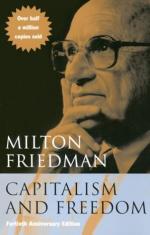
|
| Name: _________________________ | Period: ___________________ |
This test consists of 15 multiple choice questions and 5 short answer questions.
Multiple Choice Questions
1. In Friedman's analysis, what century is the historical exception to most men living in tyranny, servitude, and misery?
(a) 20th.
(b) 19th.
(c) 18th.
(d) 17th.
2. What is the name of the system with the purpose of regulating monetary policy between leading countries?
(a) The International Monetary System.
(b) The Bretton Woods System.
(c) The Gold Standard System.
(d) The World Bank System.
3. Friedman believes that all of the following are appropriate for fiscal policy except ______.
(a) Planning for stable tax rates.
(b) Spending based on community priorities.
(c) Fluctuating in spending based on the political climate.
(d) Avoiding erratic changes in spending.
4. Past and current definitions of liberalism are the same with respect to ______.
(a) Civil freedoms and democracy.
(b) Distribution of wealth and the welfare state.
(c) Paternalism and individualism.
(d) Free markets and the rule of law.
5. What is the term for currency not being traded for any amount of another currency?
(a) Unconvertible.
(b) Irreversible.
(c) Inconvertible.
(d) None of the answers is correct.
6. According to Friedman, what conflicts with one another for men?
(a) Absolute freedom.
(b) Religious beliefs.
(c) Economic interests.
(d) Political ideology.
7. Friedman states that government should be ______.
(a) Expanded.
(b) Destroyed.
(c) Held accountable.
(d) Limited.
8. One of Friedman's claims for government involvement in education asserts that there are ______ to education.
(a) Negative externalities.
(b) Extreme costs.
(c) Positive externalities.
(d) Minimal costs.
9. Which term describes the purpose of federal spending?
(a) "Seesaw."
(b) "Balance beam."
(c) None of the answers is correct.
(d) "Balance wheel."
10. According to Friedman, what cannot exist without a literate and informed population?
(a) First world countries.
(b) A progressive political system.
(c) Democratic societies.
(d) A well-armed militia.
11. In Friedman's opinion, what should individuals be allowed to do?
(a) Print their own money.
(b) Pursue their own ends.
(c) Elect their own leaders.
(d) Choose their own religion.
12. By Friedman's account, the market permits unanimity without ______.
(a) Conformity.
(b) Solitude.
(c) Freedom.
(d) Resentment.
13. According to Friedman, which of the following is the least bad?
(a) Public regulation.
(b) Private monopoly.
(c) Public monopoly.
(d) Private regulation.
14. Friedman believes that free markets are not sufficient for political freedom since many countries demonstrate the possibility of ______.
(a) Authoritarian capitalism.
(b) Economic freedom.
(c) Laissez-faire markets.
(d) Dictatorial government.
15. What does Friedman assert is an example of an appropriate task for government?
(a) Defining property rights.
(b) Regulating the job market.
(c) Determining price.
(d) Providing for the social welfare.
Short Answer Questions
1. Which of the following does Friedman dispute?
2. Friedman uses the example of selling ______ to demonstrate a true global economy.
3. The thought that the best use of government spending would be on useless projects is known as ______.
4. Instead of government spending, what does Friedman advocate the government use to stabilize the economy?
5. One role of government argued by the New Deal was to ______.
|
This section contains 480 words (approx. 2 pages at 300 words per page) |

|




